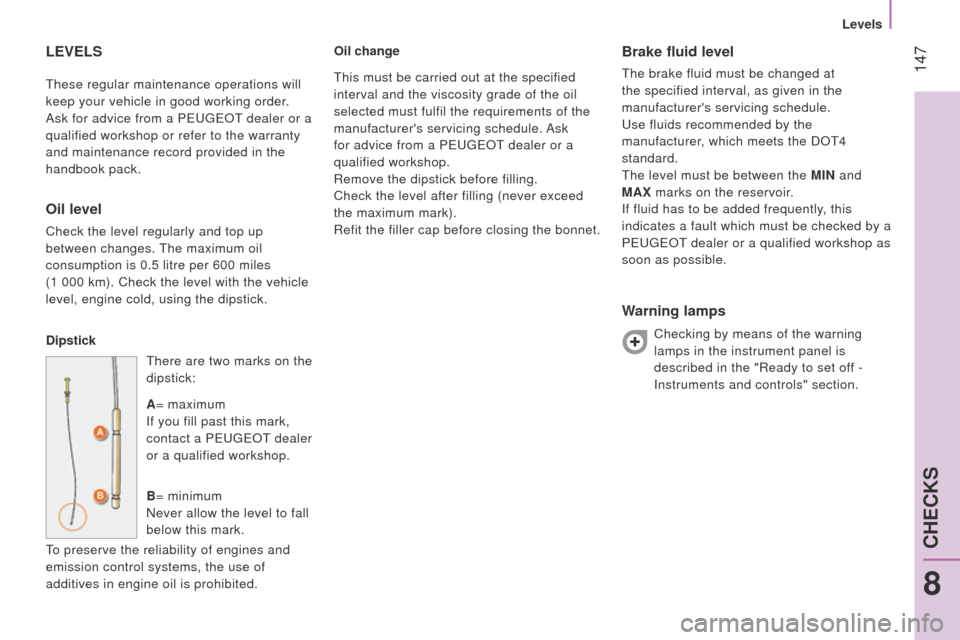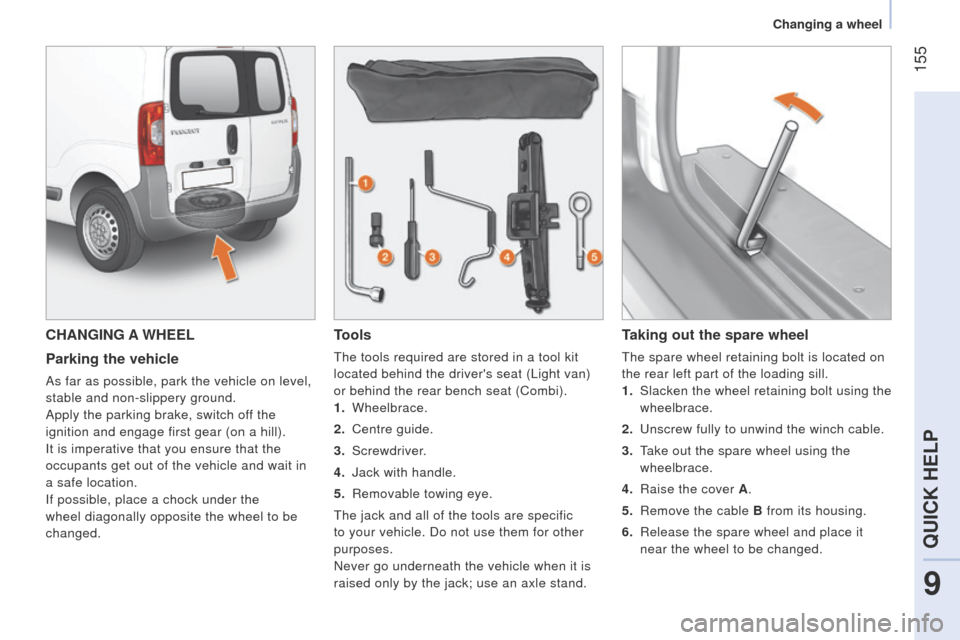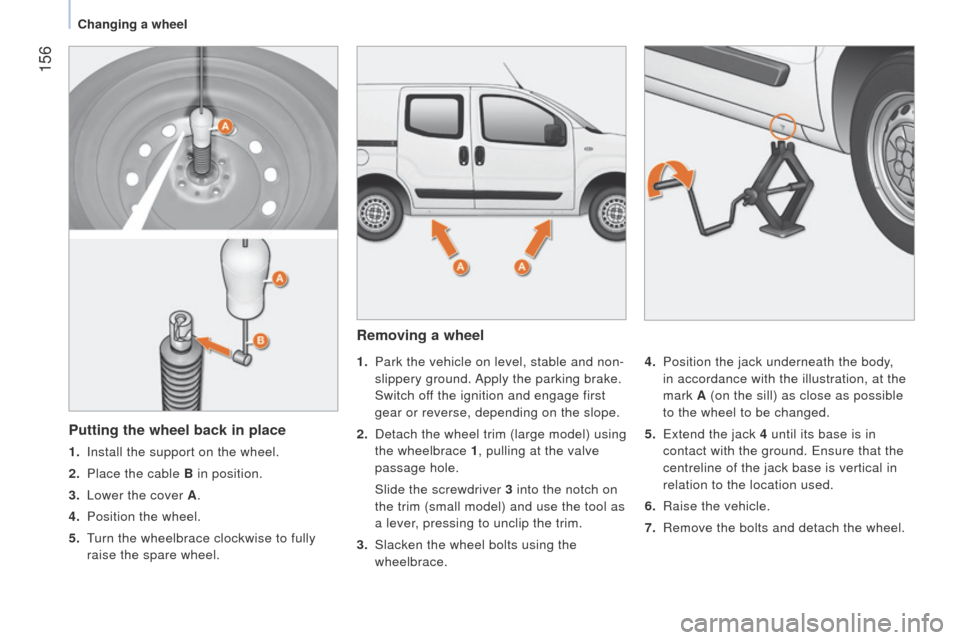2014.5 Peugeot Bipper brake
[x] Cancel search: brakePage 148 of 192

146
Bipper_en_Chap08_verifications_ed02-2014
PETROL ENGINE
take care when doing anything under
the bonnet.
1.
Screenwash reservoir
.
2.
Fusebox.
3.
e
ngine coolant header tank.
4.
Brake and clutch fluid reservoir
.
5.
Air filter
.
6.
Dipstick.
7.
e
ngine oil filler cap.
8.
Power steering fluid reservoir
.
Under the bonnet
Page 149 of 192

147
Bipper_en_Chap08_verifications_ed02-2014
these regular maintenance operations will
keep your vehicle in good working order .
Ask for advice from a P
euge O t
dealer or a
qualified workshop or refer to the warranty
and maintenance record provided in the
handbook pack.
LEVELS
Oil level
Check the level regularly and top up
between changes.
t
he maximum oil
consumption is 0.5 litre per 600 miles
(1 000
km). Check the level with the vehicle
level, engine cold, using the dipstick.
Dipstick
t
here are two marks on the
dipstick:
A = maximum
If you fill past this mark,
contact a P
euge O t
dealer
or a qualified workshop.
B = minimum
Never allow the level to fall
below this mark.
to preserve the reliability of engines and
emission control systems, the use of
additives in engine oil is prohibited. Oil change
Brake fluid level
the brake fluid must be changed at
the specified interval, as given in the
manufacturer's servicing schedule.
u
se fluids recommended by the
manufacturer, which meets the DO
t 4
standard.
t
he level must be between the MIN and
MAX marks on the reservoir.
If fluid has to be added frequently, this
indicates a fault which must be checked by a
P
euge O t
dealer or a qualified workshop as
soon as possible.
Warning lamps
Checking by means of the warning
lamps in the instrument panel is
described in the "Ready to set off -
Instruments and controls" section.
t
his must be carried out at the specified
interval and the viscosity grade of the oil
selected must fulfil the requirements of the
manufacturer's servicing schedule. Ask
for advice from a P
euge
O
t
dealer or a
qualified workshop.
Remove the dipstick before filling.
Check the level after filling (never exceed
the maximum mark).
Refit the filler cap before closing the bonnet.
8
CHECKS
Levels
Page 150 of 192

148
Bipper_en_Chap08_verifications_ed02-2014
Engine coolant level
Only use the fluid recommended by the
manufacturer. Otherwise, you risk seriously
damaging your engine. When the engine
is warm, the temperature of the coolant is
controlled by the engine cooling fan. As this fan
can operate with the ignition key removed and
because the cooling system is pressurised,
wait for at least one hour after the engine has
stopped before carrying out any work.
Topping up
t
he level must be between the MIN and
MAX marks on the header tank. If more than
1 litre of fluid is required to top up the level,
have the system checked by a P
euge O t
dealer or a qualified workshop.
Power steering fluid level
the vehicle must be parked on level ground
with the engine cold. u nscrew the cap with
integral gauge and check the level which
must be between the MIN and MAX marks.
Screenwash fluid level
For optimum cleaning and to avoid freezing,
topping up or replacement of this fluid
should never be with plain water; we
recommend the use of products available
from P
euge O t
dealers.
Capacity of the reservoir: approximately
3
litres.
Slacken the cap by two turns to release the
pressure to prevent any risk of scalding.
When the pressure has dropped, remove the
cap and top up the level with coolant.
If fluid has to be added frequently, this
indicates a fault which must be checked by a
P
euge
O
t
dealer or a qualified workshop as
soon as possible.
Used products
Avoid prolonged contact of used oil with the
skin.
Brake fluid is harmful to health and very
corrosive.
Do not dispose of used oil, brake fluid or
coolant into drains or into the ground, but
into the containers provided for this purpose
at P
euge O t
dealers (France) or at an
authorised waste disposal site.
Levels
Page 151 of 192

149
Bipper_en_Chap08_verifications_ed02-2014
CHECKS
Bleeding water from the Diesel filter
If this warning lamp comes
on, you must bleed the filter;
otherwise bleed the filter
regularly, every time the engine
oil is changed.
to remove the water
, unscrew the bleed
screw or the water in Diesel sensor, located
at the base of the filter. Operate until all of
the water has flowed out.
t
hen tighten the
bleed screw or the water sensor.
Battery
At the start of winter, have your battery
checked by a P euge O t
dealer or a
qualified workshop.
Air filter and passenger compartment
filter
A blocked passenger compartment filter
may reduce the performance of the
air conditioning system and generate
undesirable odours.
t
he replacement
intervals for these components are indicated
in the warranty and maintenance record.
Depending on the environment (dusty
atmosphere...) and the use of the vehicle
(urban driving...), change them twice as
often if necessary.
Brake pads
Brake pad wear depends on the type of
driving, in particular for vehicles which are
used in town, over short distances. It may
be necessary to check the brake pad wear,
even between services.
u
nless there is a leak on the system, a drop
in the brake fluid level indicates that the
brake pads are worn.
Brake disc / drum wear
For all information on checking the brake
disc / drum wear, contact a P euge O t
dealer or a qualified workshop.
Parking brake
Where the parking brake travel is too great
or there is a reduction in the performance
of the system, the parking brake should be
adjusted, even between services.
Have the system checked by a P
euge O t
dealer or a qualified workshop.
Oil filter
Change the filter regularly, in accordance
with the manufacturer's servicing schedule.
t
he presence of this label, in particular
with the Stop & Start system, indicates the
use of a specific 12 V lead-acid battery
with special technology and specification.
t
he involvement of a P
euge
O
t
dealer
or a qualified workshop is essential when
replacing or disconnecting the battery.
Refer to the "Checks -
u
nder the
bonnet" section.
HDi engines use advanced
technology. All work requires
specialist knowledge, which all P
euge
O
t
dealers have.
8
CHECKS
Checks
Page 152 of 192

150
Bipper_en_Chap08_verifications_ed02-2014
Manual gearbox
the gearbox does not require any
maintenance (no oil change).
Refer to the warranty and maintenance
record for the checking interval for this
component.
Good practice
to check the main levels and certain
components, in accordance with the
manufacturer's servicing schedule, refer to
the pages of the warranty and maintenance
record which correspond to your vehicle's
engine.
Electronic gearbox
the gearbox does not require any
maintenance (no oil change).
Refer to the warranty and maintenance
record for details of the checking interval
for this component.
Only use products recommended by
P
euge O t
or products of equivalent
quality and specification.
In order to optimise the operation of units as
important as the braking system, P
euge O t
selects and of
fers specific products.
In order to avoid damaging the electrical
units, high pressure washing to clean the
engine compartment is strictly prohibited.
After washing the vehicle dampness, or in
winter, ice may form on the brake discs and
pads: braking efficiency may be reduced.
Make some light brake applications to dry
and de-ice the brakes.
Checks
Page 157 of 192

155
Bipper_en_Chap09_aide-rapide_ed02-2014
CHANGING A WHEEL
Parking the vehicle
As far as possible, park the vehicle on level,
stable and non-slippery ground.
Apply the parking brake, switch off the
ignition and engage first gear (on a hill).
It is imperative that you ensure that the
occupants get out of the vehicle and wait in
a safe location.
If possible, place a chock under the
wheel diagonally opposite the wheel to be
changed.
Tools
the tools required are stored in a tool kit
located behind the driver's seat ( l ight van)
or behind the rear bench seat (Combi).
1.
Wheelbrace.
2.
Centre guide.
3.
Screwdriver.
4.
Jack with handle.
5.
Removable towing eye.
t
he jack and all of the tools are specific
to your vehicle. Do not use them for other
purposes.
Never go underneath the vehicle when it is
raised only by the jack; use an axle stand.
Taking out the spare wheel
the spare wheel retaining bolt is located on
the rear left part of the loading sill.
1.
Slacken the wheel retaining bolt using the
wheelbrace.
2.
u nscrew fully to unwind the winch cable.
3.
t
ake out the spare wheel using the
wheelbrace.
4.
Raise the cover
A.
5.
Remove the cable
B from its housing.
6.
Release the spare wheel and place it
near the wheel to be changed.
9
QUICK HELP
Changing a wheel
Page 158 of 192

156
Bipper_en_Chap09_aide-rapide_ed02-2014
Removing a wheel
1. Park the vehicle on level, stable and non-
slippery ground. Apply the parking brake.
Switch off the ignition and engage first
gear or reverse, depending on the slope.
2.
Detach
the wheel trim (large model) using
the wheelbrace 1 , pulling at the valve
passage hole.
Slide the screwdriver
3 into the notch on
the trim (small model) and use the tool as
a lever, pressing to unclip the trim.
3.
Slacken the wheel bolts using the
wheelbrace. 4.
Position the jack underneath the body ,
in accordance with the illustration, at the
mark A (on the sill) as close as possible
to the wheel to be changed.
5.
e xtend the jack 4 until its base is in
contact with the ground.
e nsure that the
centreline of the jack base is vertical in
relation to the location used.
6.
Raise the vehicle.
7.
Remove the bolts and detach the wheel.
Putting the wheel back in place
1. Install the support on the wheel.
2.
Place the cable
B in position.
3.
l ower the cover A .
4.
Position the wheel.
5.
t
urn the wheelbrace clockwise to fully
raise the spare wheel.
Changing a wheel
Page 160 of 192

158
Bipper_en_Chap09_aide-rapide_ed02-2014
TEMPORARY PUNCTURE REPAIR KIT
this kit is located at the front of the
passenger compartment. It consists of:
-
a repair cartridge
A, containing the
sealant, equipped with:
●
a filling
pipe B,
●
a
sticker C
indicating "max. 80 km/h", which
the driver must affix to the dashboard in a
visible position after repairing the tyre,
-
a compressor
D equipped with a pressure
gauge and unions,
-
adaptors for the inflation of various items,
-
a pair of protective gloves,
-
a quick guide to use of the temporary
puncture repair kit.
Repair procedure
- Apply the parking brake and place the
gear lever in neutral.
-
u nscrew the valve cap of the tyre to be
repaired.
-
t
ake out the filling pipe
B and screw the
ring E onto the tyre valve.
-
Check that the on/of
f switch F on the
compressor is in position "0" (off). -
Start the engine.
-
Insert the connector
G
in the nearest
12 V accessory socket in the vehicle.
-
Place the compressor
’s on/off switch F
in
position "1" (on).
-
Inflate the tyre to a pressure of 3 bars.
to obtain a more accurate reading, you are
advised to check the pressure value on the
pressure gauge H , with the compressor off.
t
his temporary puncture repair kit is
available from P euge O t
dealers.
It is provided for the repair of holes of
a maximum diameter of 4 mm, located
exclusively on the tread or side wall of the
tyre. Avoid removing any foreign bodies
which have penetrated into the tyre.
Changing a wheel